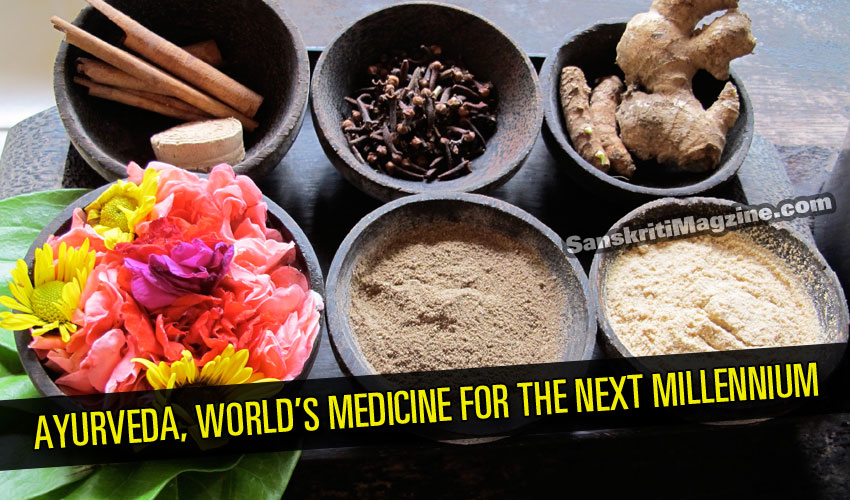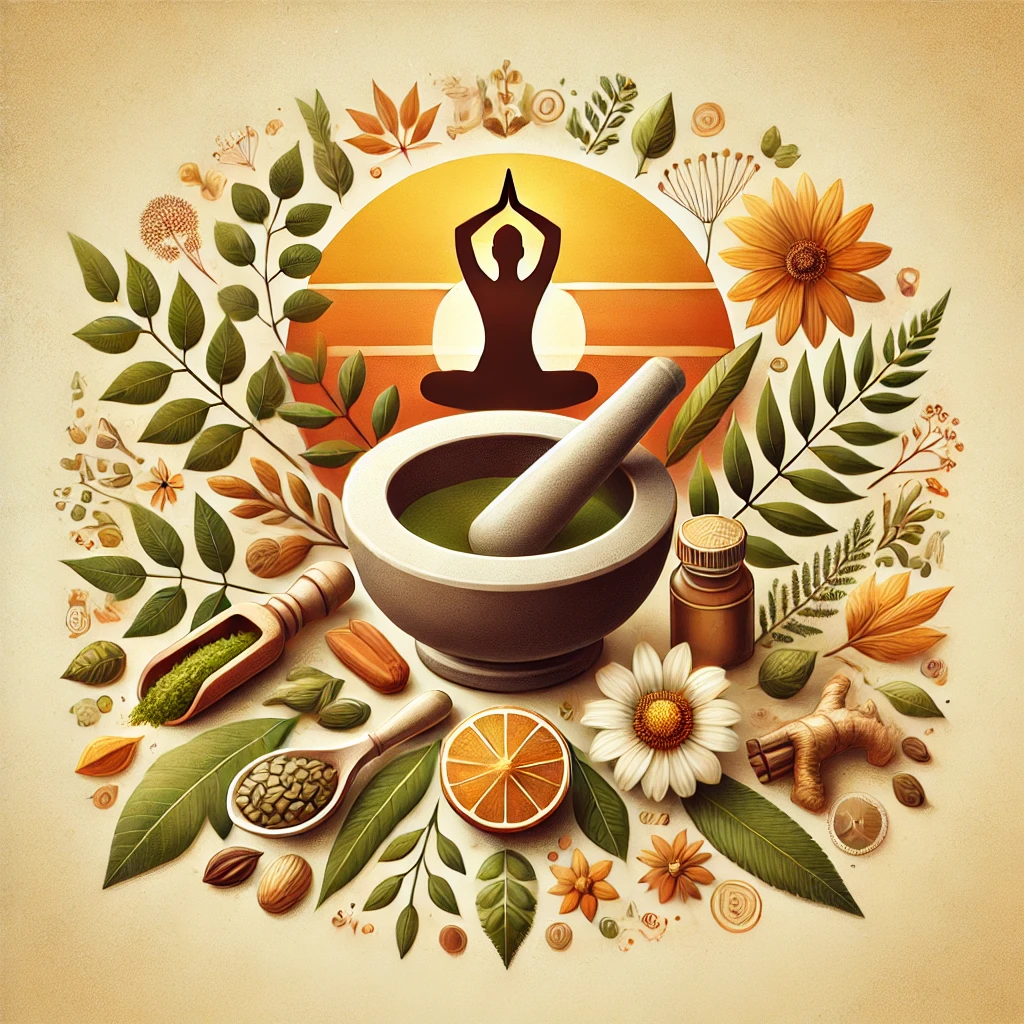By Dr. David Frawley (Vamadeva Shastri) Published in India Post June 25, 1999,
I was attending a conference on Yoga and medicine in Mumbai.There were a number of Indian medical doctors on the panel but, strangely as a Westerner, I was the only Ayurvedic speaker. After my talk promoting Ayurveda, someone in the audience remarked, “We in India believe in something only once it has been reimported.” While most Indian medical minds are pursuing modern medicine, Americans are pursuing alternative medicine are looking to Ayurveda and see India as the homeland of Ayurveda and spirituality.
India’s profound cultural medical genius has recently gone into modern medicine. Even families traditionally devoted to Ayurveda have switched over to modern medicine and have forgotten their roots. Indian allopathic doctors are often opposed to Ayurveda, which, with their Western education, they consider to be primitive. Indeed, I have found that doctors in America are often more interested in Ayurveda than doctors in India who have a na?ve faith in modern medicine such as was typical during the fifties and sixties in this country.
Unfortunately, Ayurveda is not adequately funded in India today, receiving only about one percent of the medical budget. This amount is only enough to pay a low wage for Ayurvedic teachers. While the government funds allopathic treatment, people generally have to pay out of their own pockets for Ayurveda. This poor funding of Ayurveda is responsible for the backward state that sometimes occurs for Ayurvedic schools and hospitals, not anything inferior about the medicine itself.
Today there are several hundred Ayurvedic schools in India and thousands of practitioners, who are particularly active in the villages. Ayurvedic herb stores can be found in most communities, offering a wide variety of health care products. Modern Ayurvedic schools teach Ayurveda along with allopathy and the average Ayurvedic doctor knows a lot about modern medicine, including its diagnostic methods. Ayurveda is recognized by the World Health Organization (WHO) and is the subject of much modern medical research. So in spite of poor funding, Ayurveda is still flourishing in India.
A new modern Ayurveda is also starting in India and in the West with Ayurvedic health spas that can be quite upscale in terms of facilities and treatment. This is not confined to the TM (Transcendental Meditation) movement, which has emphasized it, but includes hotels in South India and other Ayurvedic centers throughout the world sponsored by various groups and organizations. There is nothing necessarily archaic or poverty-based about Ayurveda. Indeed the new Ayurveda, like Yoga, is attended by movie stars and those in pursuit of the spiritual life, who in America are often affluent. The interest in Ayurveda in the West is helping to revive Ayurveda in India and make it more respectable, an important medical system in its own right, not just a poor alternative for those who do not have access to modern medicine.
Ayurveda has a long and glorious history in India, going back to Vedic or Indus-Sarasvati times over five thousand years ago. Classical Ayurveda includes Charaka Samhita, Sushruta Samhitaand Ashtanga Hridaya, as its three main classics. No other region in the world, not Europe or China has preserved such extensive medical texts of great antiquity that are still used today.
Ayurveda is mentioned in the Vedas, Upanishads, Mahabharata, Puranas, Tantras and Yoga Shastras. It was used by the Buddhists, Jains and Sikhs as well as Hindus, and forms the basis of Tibetan medicine. Many great modern Yogis like Sri Aurobindo, Swami Shivananda of Rishikesh and Paramahansa Yogananda have spoken highly about Ayurveda and used it with their students. Most Yoga centers in India and the West now offer Ayurvedic classes or treatments.
Ayurveda and Modern Medicine
Modern medicine is recognizing that we must consider the nature of the individual in health and disease. It is not enough to give the same treatment to everyone suffering from the same disease. Their individual makeup should be considered because it causes the symptoms and development of the disease to vary.
Ayurveda contains perhaps the world’s best system of constitutional types that helps us treat each individual appropriately. Ayurveda classifies people according to the three doshas or biological humors of Vata, Pitta and Kapha, (which correspond roughly to the air, fire and water elements energized by the life-force). From these three main types there are many subtypes and conditions, resulting in a unique analysis of each individual’s health condition. This typology is not the product of any single factor like the current popular blood types in naturopathic medicine, but reflects the whole range of biological manifestations from body frame and weight, facial features, digestive tendencies, disease tendencies, and psychological indications. Ayurvedic books contain such typology tests and Ayurvedic doctors spend much time determining the individual nature and needs of each patient based upon these considerations.

Ayurveda treats the individual more so than the disease. It makes the individual important and strengthening his or her vitality the goal, regarding the disease manifestation as secondary and derivative. It says that the same individual will be prone to various diseases that reflect their individual make-up. Therefore Ayurveda can provide a treatment that covers not only a specific illness but all the potential diseases that the individual is likely to get.
Modern medicine is realizing the importance of disease prevention. It is not enough to treat diseases after they arise. That is like putting out a fire after it has already started and done some damage. Real treatment is to prevent disease from happening in the first place. And many diseases that are difficult to treat once they are fully developed can be prevented, if caught early enough.
Ayurveda is based upon a firm foundation of disease prevention, which is not simply a matter of regular medical check-ups but requires a healthy lifestyle in harmony with one’s own individual constitution and unique life-circumstances. According to Ayurveda, disease arises mainly from a breakdown of the balance of internal energies in a person, not merely from external pathogens, however powerful these may be. Ayurveda’s main method of long term treatment is to strengthen our internal energy (ojas). This is similar to modern medicine’s effort to strengthen the immune system, which is the energy of our body to defend itself from outside attacks. But Ayurveda has a better understanding of this internal energy and its connections with mind and consciousness. It views our vital energy not merely as a biochemical phenomenon but as a product of the mind and prana which are not limited to our physical structure.
In the modern world we are gradually discovering the importance of the mind and emotions in the disease process. Ayurveda is inherently a mind-body medicine. The doshas or biological humors are not simply physical factors of pathogens, elemental imbalances or dietary indiscretions but include the effects of impressions, emotions and thoughts. The doshas reflect the effects of anxiety, anger, and attachment on our physiology.
What junk food does to the body, junk impressions, such as our mental diet of violent movies, does to the mind, rendering it dull and heavy. Negative emotions impact our health by adversely affecting our internal organs, like weakening the liver and heart, which they are closely related to. Disturbed thoughts impact our health through unbalancing the flow of energy through our nervous system. Disease always has a psychological component, and psychological disorders impact our vitality in a negative way.
Ayurveda emphasizes the role of consciousness in health and disease. It understands the workings of the mind on an organic and energetic basis just as it does the workings of the body, so that we can provide proper nutrition and exercise for the mind as well as the body. It teaches us to be more conscious of how we live, what we eat, how we move, and how we think so that we can bring the healing power and insight of consciousness to help us live in harmony. Whatever we give consciousness to we help improve, just as exposure to sunlight helps plants grow. This spiritual side of Ayurveda is not a matter of religious dogma, occult hocus pocus or New Age fantasy but part of the sophisticated spiritual sciences of Yoga and Vedanta, with which Ayurveda is intimately connected.
Ayurveda prescribes the appropriate individual life-style health regimens designed with regard to age, sex, climate, vocation and other factors. We cannot expect to be healthy if we don’t have a good diet, if we lack proper exercise or if we are filling our minds with disturbing influences. We create our own health or disease by our daily actions. So too, without changing these habitual activities, we cannot improve our health in a lasting manner.
Ayurveda shows the health benefits of the Indian style of cooking, like how the right spices can help us digest food better. It teaches us the dynamic effects of each food article for health and disease. While modern medicine is only now beginning to accept the role of food and disease through an examination of phytochemicals, Ayurveda has long regarded diet as the basis of health. We are not only what we eat but also how we eat and with whom we eat. Food preparation is as important as food types.

Food is the first form of God, the Anna Brahma of the Upanishads. Without honoring this form of divinity, the other forms may not be able to manifest in our lives. In this regard Ayurveda recommends vegetarian foods to promote higher (sattvic) qualities of compassion and understanding, under the idea that food not only nourishes the body but also the mind and emotions.
Ayurveda has many important herb and mineral preparations that reflect the botanical wealth of the Indian subcontinent and thousands of years of experience with plants. Ayurveda has the most complex and intricate herbal pharmaceutical industry in the world with pills, powders, resins, extracts, confections, and oils not to mention Ayurvedic cosmetics, toothpastes and soaps. Such Ayurvedic products can improve our lives in all aspects.
Ayurveda works along with Yoga to prescribe helpful asana, pranayama, mantra and meditation methods for optimal health and spiritual development. The asanas that are good for one person or good for one season, just like the food articles, may not be good for another. Pranayama also has its energetic effects. By strengthening Prana or the life-force we can improve perception and circulation and add more energy to counter all diseases. Indeed Prana is the second form of God, the Prana Brahma of the Upanishads.
Mantra and meditation practices have their energetics that should be adjusted according to individual needs and capacities. Mantra helps us energize the mind and clear the subconscious. Meditation helps us open our higher awareness potentials so that we can deal with our lives with more insight and detachment.
Ayurveda has an extensive system of detoxification called Pancha Karma. Pancha Karma includes a system of oil massage, sweating therapy, and various internal cleansing processes to remove the doshas from the tissues, which is to effectively eliminate disease-causing toxins from the body so that they cannot promote the disease process. A number of Pancha Karma centers are now functioning in the West and most Ayurvedic clinics in India offer this service.
Ayurveda has a special science of rejuvenation or rasayana. It recognizes that the body contains a secret potential to renew itself in old age, just it does daily in the state of deep sleep. Ayurveda contains specific exercise, diet, and meditation regimens to facilitate the rejuvenation of body and mind. As the baby boomer generation, which has been very active physically and has pioneered the new interest in alternative medicine, gets older, this rejuvenation approach is bound to become not only more relevant but more popular.
Perhaps most important, with its broad basis, Ayurveda provides a good model for integrating all the worlds different medical systems in a harmonious manner. It recognizes the importance of surgery, particularly for larger tumors, but also its limitations, its weakening of our internal energy. It recognizes the importance of drugs, particularly for acute pain relief, but also their limitations, their tendency to dull the mind and depress our energy. It accepts the healing power of food, herbs, massage, and other natural healing methods and shows their applicability and long term healing power.
Yet while respecting all healing modalities Ayurveda also shows us how we can heal ourselves. What we do for ourselves on a regular basis, through the food, thoughts and lifestyle we choose creates who we are and shapes where we are going in life. To think that an outside force, whether it be the medical establishment or an act of God, can suddenly heal what has taken perhaps years to create, is illusory and a form of victim-consciousness. It is an abdication of responsibility for our choices moment by moment. Even in Ayurveda, the practitioner can make recommendations, but it is up to the client to implement them on a regular basis.
Future of Ayurveda
Ayurveda is becoming one of the main world systems of natural healing and mind-body medicine, with its popularity spreading not only to America but also to Europe and East Asia, a trend that has been steadily developing over the last fifteen years. However, in America Ayurveda is mainly being taken up by the general population. Few Indians, particularly the many medical doctors, are supporting it or are even informed about it.
The current Prime Minister of India, Atal Bihari Vajpayee, has mentioned the importance of Ayurveda for proper medical care in India, particularly for disease prevention. The same comments extend even more to the West where acute disease is no longer the main issue but rather how to improve our vitality and awareness for more creative and fulfilling lives.
As we move into a new millennium and a global age, Vedic knowledge of all types, with its universal vision, is becoming increasingly important. This includes Ayurveda, Yoga, Vedic Astrology, Vedanta and Sanskrit. But as we are first of all physical creatures and as our health needs are radically changing in the computer world, Ayurveda may be the main vehicle through which Vedic knowledge comes to the West. Through the Vedic approaches of Ayurveda, Yoga and Jyotish (Vedic Astrology,) we have an elaborate system for self-healing, self-understanding, and self-realization.
With such a wealth of knowledge Indians, particularly NRIs should be aware of Ayurveda and strive to promote it not only in the West but also in India. Indian physicians should form a committee to study and promote Ayurveda and strive to integrate helpful Ayurvedic approaches into modern medicine.










